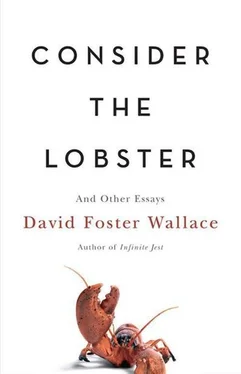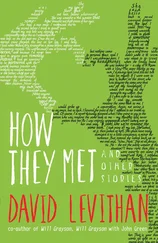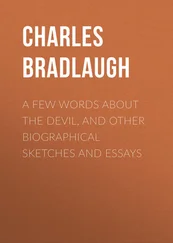My own next-door neighbor, a retired bookkeeper and USAF vet whose home- and lawn-care are nothing short of phenomenal, has a regulation-size anodized flagpole secured in eighteen inches of reinforced cement that none of the other neighbors like very much because they feel it draws lightning. He says there’s a very particular etiquette to having your flag at half-mast: you’re supposed to first run it all the way up to the finial at the top and then bring it halfway down. Otherwise it’s some kind of insult. His flag is out straight and popping smartly in the wind. It’s far and away the biggest flag on our street. You can also hear the wind in the cornfields just south; it sounds roughly the way light surf sounds when you’re two dunes back from the shore. Mr. N—’s pole’s halyard has metal elements that clank against the pole when it’s windy, which is something else the neighbors don’t much care for. His driveway and mine are almost right together, and he’s out here on a stepladder polishing his pole with some kind of special ointment and a chamois cloth — I shit you not — although in the morning sun it’s true that his metal pole does shine like God’s own wrath.
“Hell of a nice flag and display apparatus, Mr. N—.”
“Ought to be. Cost enough.”
“Seen all the other flags out everywhere this morning?”
This gets him to look down and smile, if a bit grimly. “Something, isn’t it.” Mr. N— is not what you’d call the friendliest next-door neighbor. I really only know him because his church and mine are in the same softball league, for which he serves with great seriousness and precision as his team’s statistician. We are not close. Nevertheless he’s the first one I ask:
“Say, Mr. N—, suppose somebody like a foreign person or a TV reporter or something were to come by and ask you what the purpose of all these flags after what happened yesterday was, exactly — what do you think you’d say?”
“Why” (after a little moment of him giving me the same sort of look he usually gives my lawn), “to show our support towards what’s going on, as Americans.” *
The overall point being that on Wednesday here there’s a weird accretive pressure to have a flag out. If the purpose of displaying a flag is to make a statement, it seems like at a certain point of density of flags you’re making more of a statement if you don’t have a flag out. It’s not totally clear what statement this would be, though. What if you just don’t happen to have a flag? Where has everyone gotten these flags, especially the little ones you can fasten to your mailbox? Are they all from the Fourth of July and people just save them, like Christmas ornaments? How do they know to do this? There’s nothing in the Yellow Pages under Flag . At some point there starts to be actual tension. Nobody walks by or stops their car and says, “Hey, how come your house doesn’t have a flag?” but it gets easier and easier to imagine them thinking it. Even a sort of half-collapsed house down the street that everybody thought was abandoned has one of the little flags on a stick in the weeds by the driveway. None of Bloomington’s grocery stores turn out to stock flags. The big novelty shop downtown has nothing but Halloween stuff. Only a few businesses are actually open, but even the closed ones are now displaying some sort of flag. It’s almost surreal. The VFW hall is obviously a good bet, but it can’t open until noon if at all (it has a bar). The counter lady at Burwell Oil references a certain hideous KWIK-N-EZ convenience store out by I-55 at which she’s pretty sure she recalls seeing some little plastic flags back in the racks with all the bandannas and NASCAR caps, but by the time I get down there they all turn out to be gone, snapped up by parties unknown. The cold reality is that there is not a flag to be had in this town. Stealing one out of somebody’s yard is clearly just out of the question. I’m standing in a fluorescent-lit KWIK-N-EZ afraid to go home. All those people dead, and I’m sent to the edge by a plastic flag. It doesn’t get really bad until people come over and ask if I’m OK and I have to lie and say it’s a Benadryl reaction (which in fact can happen).
… And so on until, in one more of the Horror’s weird twists of fate and circumstance, it’s the KWIK-N-EZ proprietor himself (a Pakistani, by the way) who offers solace and a shoulder and a strange kind of unspoken understanding, and who lets me go back and sit in the stockroom amid every conceivable petty vice and indulgence America has to offer and compose myself, and who only slightly later, over styrofoam cups of a strange kind of perfumey tea with a great deal of milk in it, suggests construction paper and “Magical Markers,” which explains my now-beloved and proudly displayed homemade flag.
AERIAL & GROUND VIEWSEveryone here gets the local news organ, the Pantagraph, which is roundly loathed by most of the natives I know. Imagine, let’s say, a well-funded college newspaper co-edited by Bill O’Reilly and Martha Stewart. Wednesday’s headline is: After two pages of AP stuff, you get to the real Pantagraph . Everything to follow is sic . Wednesday’s big local headers are: STUNNED CITIZENS RUN THROUGH MANY EMOTIONS; CLERGY OPEN ARMS TO HELP PEOPLE DEAL WITH TRAGEDY; ISU PROFESSOR: B-N NOT A LIKELY TARGET; PRICES ROCKET AT GAS PUMPS; AMPUTEE GIVES INSPIRATIONAL SPEECH. There’s a half-page photo of a student at Bloomington Central Catholic HS saying the rosary in response to the Horror, which means that some staff photographer came in and popped a flash in the face of a traumatized kid at prayer. The Op-Ed column for 9/12 starts out: “The carnage we have seen through the eyes of lenses in New York City and Washington, D.C., still seems like an R-rated movie out of Hollywood.”
Bloomington is a city of 65,000 in the central part of a state that is extremely, emphatically flat, so that you can see the town’s salients from way far away. Three major interstates converge here, and several rail lines. The town’s almost exactly halfway between Chicago and St. Louis, and its origins involve being an important train depot. Bloomington is the birthplace of Adlai Stevenson and the putative hometown of Colonel Blake on M*A*S*H . It has a smaller twin city, Normal, that’s built around a public university and is a whole different story. Both towns together are like 110,000 people.
As Midwest cities go, the only remarkable thing about Bloomington is its prosperity. It is all but recession-proof. Some of this is due to the county’s farmland, which is world-class fertile and so expensive per acre that a civilian can’t even find out how much it costs. But Bloomington is also the national HQ for State Farm, which is the great dark god of US consumer insurance and for all practical purposes owns the town, and because of which Bloomington’s east side is now all smoked-glass complexes and Build to Suit developments and a six-lane beltway of malls and franchises that’s killing off the old downtown, plus an ever-wider split between the town’s two basic classes and cultures, so well and truly symbolized by the SUV and the pickup truck, respectively. *
Winter here is a pitiless bitch, but in the warm months Bloomington is a lot like a seaside community except here the ocean is corn, which grows steroidically and stretches to the earth’s curve in all directions. The town itself in summer is intensely green — streets bathed in tree-shade and homes’ explosive gardens and dozens of manicured parks and ballfields and golf courses you almost need eye protection to look at, and broad weedless fertilized lawns all made to line up exactly flush to the sidewalk with special edging tools. Ý To be honest, it’s all a little creepy, especially in high summer, when nobody’s out and all that green just sits in the heat and seethes.
Читать дальше












